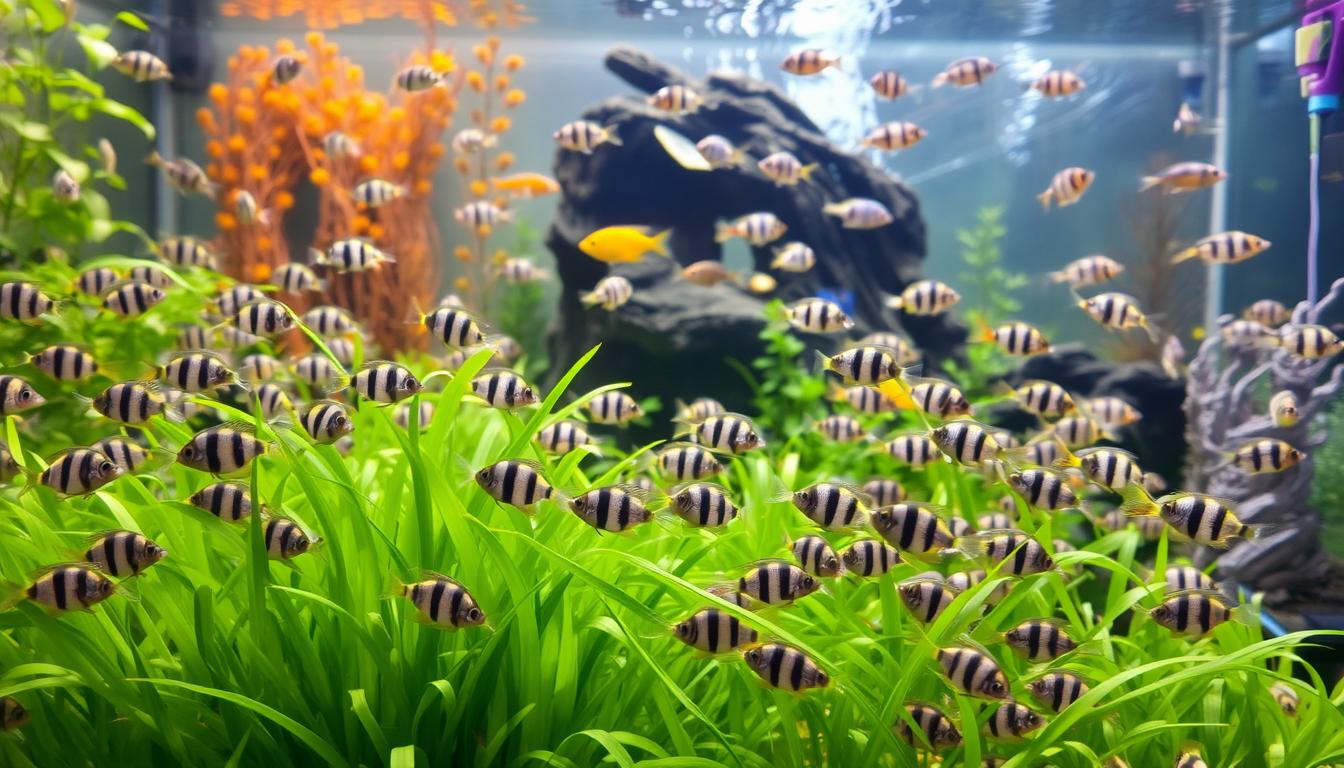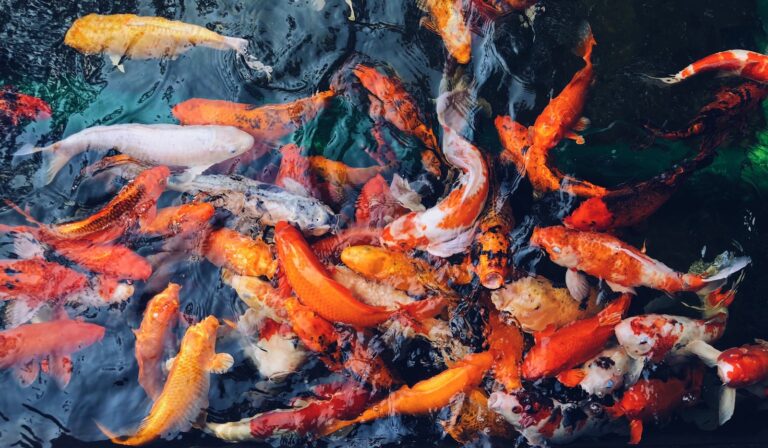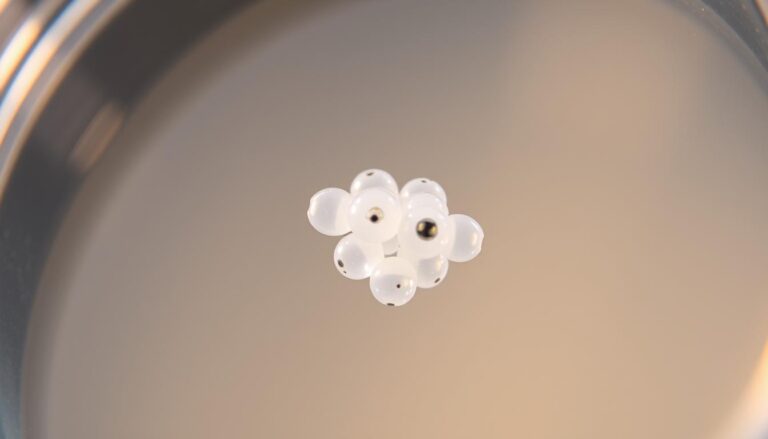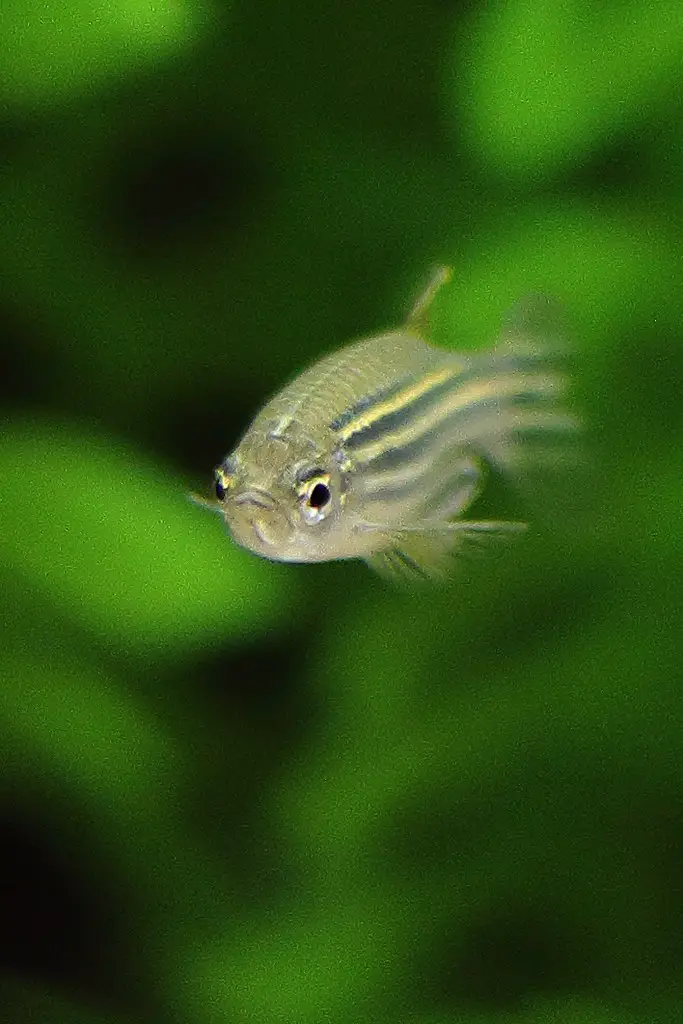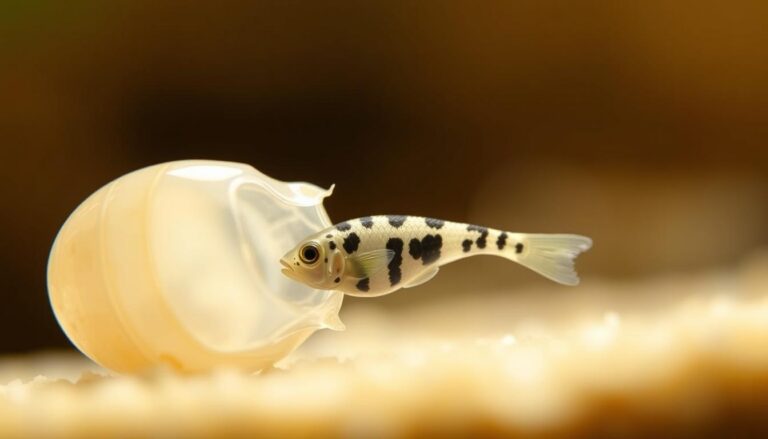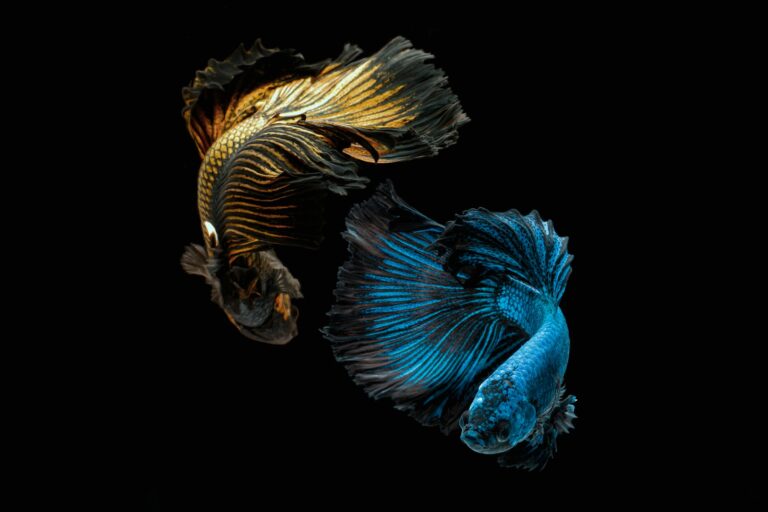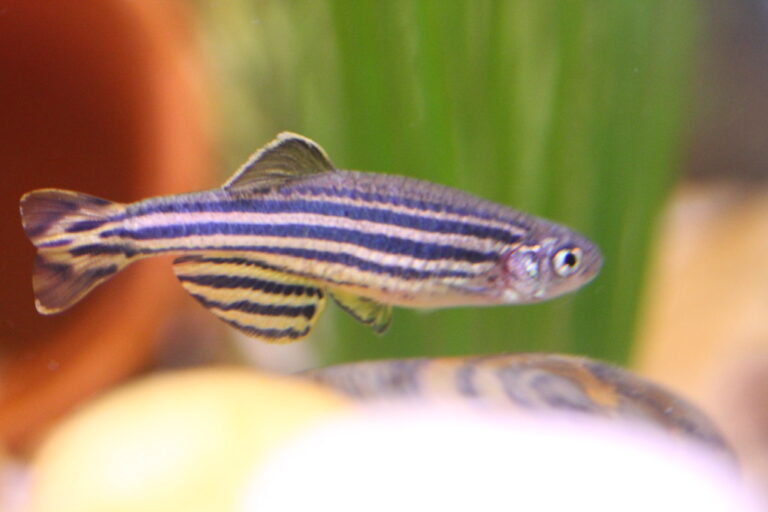Best Zebra Danio Temperature: What You Need to Know
Keeping the right temperature is key for zebra danios’ health and happiness. These colorful fish are known for being tough, but they need the right water conditions to thrive. The perfect Zebra Danio Temperature and water parameters keep them active and healthy in your aquarium.
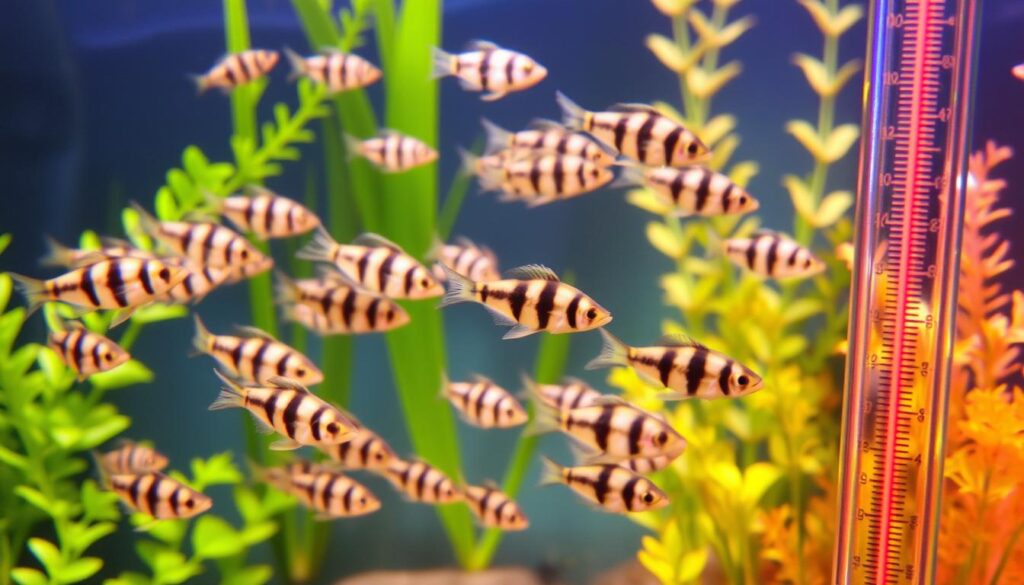
This guide will tell you the best temperature range for them. You’ll learn how it affects their behavior. You’ll also find out about heaters and thermometers, and how to avoid temperature mistakes. Small changes can make a big difference for your fish.
Table of Contents
Key Takeaways
- Zebra danios need a temperature range of 65–75°F to stay healthy.
- Optimal water temperature affects their swimming and feeding habits.
- Regular checks with thermometers prevent stress and disease.
- Sudden temperature changes can harm their immune systems.
- Proper danio water parameters include stable temperatures and clean water.
Understanding Zebra Danios: An Overview
Zebra danios are small, vibrant fish that catch the eye of aquarium lovers everywhere. To keep them healthy, it’s important to know where they come from and how they act. Their background and behavior guide the danio fish care needed for a thriving tank.
Natural Habitat and Origin
Wild zebra danios come from the warm, flowing waters of South Asia. They live in the Ganges and Brahmaputra river basins. These areas have a zebra danio habitat with moderate temperatures and clear, oxygen-rich streams.
Making a tank like this helps keep them healthy. It includes the right zebra danio temperature range.
Physical Characteristics and Behavior
These fish have striking horizontal blue and silver stripes. They can grow up to 2 inches. They love to swim and school in groups, making them lively in community tanks.
Why Zebra Danios Are Popular Among Aquarists
- Hardy survivors: They do well in different conditions, but need a stable zebra danio temperature range.
- Social yet peaceful: They get along with other small fish, reducing fights in the tank.
- Beginner-friendly: Their toughness and easy adaptability make danio fish care simple for beginners.
These qualities make them perfect for those who want beauty and simplicity in their aquariums.
The Importance of Water Temperature for Fish Health
Water temperature is more than just a number. It’s crucial for fish survival. Zebra danios, like all ectotherms, need their environment to keep their body temperature right. Their zebra danio temperature tolerance matches their natural habitats.
When temperatures change, their metabolism, breathing, and digestion also change. This is important for their health.
Big changes in temperature cause fish temperature stress. Stress weakens their immune systems, making them more likely to get sick. Changes in temperature can also mess with their eating and activity habits.
Here’s why keeping the temperature stable is important:
- Rapid changes stress fish, causing erratic swimming or loss of appetite
- Extreme cold slows digestion, risking organ damage
- Overheating speeds metabolism, draining energy reserves
Keeping the aquarium temperature stable creates a stable environment. Even small changes (like a 5°F shift) can stress fish. Many hobbyists overlook this, leading to health problems. Using the right equipment and monitoring helps protect fish health better than trying to find a single “perfect” temperature.
A stable environment supports natural behaviors and strengthens disease resistance.
Understanding these basics is key to choosing the right temperature range for zebra danios. Next sections will explore exact numbers. But remember, consistency is as important as the temperature itself.
Optimal Zebra Danio Temperature Range
To keep your zebra danios happy, knowing their danio temperature requirements is key. These colorful fish need certain temperatures to stay healthy and active.
Minimum Safe Temperature
Zebra danios can handle as low as 65°F (18°C). But, staying below 68°F (20°C) for too long makes them sluggish. They also get sick easier when it’s too cold. Watch them closely if the tank gets too chilly.
Maximum Safe Temperature
Temperatures over 80°F (26.5°C) stress zebra danios. They can handle brief spikes to 82°F (28°C), but long heat harms them. It lowers oxygen and puts pressure on their hearts, shortening their lives.
Ideal Temperature Sweet Spot
The best temperature for zebra danios is 72–76°F (22–24.5°C). This keeps them lively and stress-free. They’ll swim and eat well at these temperatures. Use a good heater and thermometer to keep it right. Avoid sudden changes to prevent shock.
How Temperature Affects Zebra Danio Behavior
Zebra danio behavior changes with water temperature. Watching these changes helps keep fish healthy. Let’s see how temperature affects their daily life and breeding.
Activity Levels at Different Temperatures
Warmer water within safe ranges boosts energy. Here’s what to watch for:
| Temperature Range (°F) | Behavioral Signs |
|---|---|
| 68–72°F | Slower movements, less social interaction |
| 73–76°F | Active swimming, schooling, and exploration |
| 77°F+ | Increased energy, but avoid exceeding 78°F |
At cooler ends (68–72°F), fish may hide. Ideal activity peaks around 74–76°F, their comfort zone.
Breeding Behavior and Temperature Correlation
Raising the temperature to 78°F can trigger breeding cycles. This zebra danio breeding temperature mimics rainy season conditions in their native habitats. Males become more vibrant and chase females when temps reach this range. Sudden spikes, though, stress them. Gradual adjustments are key.
- 78°F: Optimal for breeding stimulation
- Stable temps reduce stress during mating rituals
Observing these cues helps aquarists adjust tanks to support natural behaviors. Small shifts can mean big differences in their health and reproduction.
Seasonal Temperature Variations in the Wild
Zebra danios live in a zebra danio natural habitat in India, Bangladesh, and Nepal. They face seasonal temperature changes with monsoons and dry seasons. In the wild, wild danio temperature cycles change a lot.
Cool rains in summer make them active and ready to breed. But, warmer waters during droughts slow them down. These changes affect their feeding and migration.
- Monsoon rains: Cooler water triggers increased activity and breeding readiness.
- Hot dry seasons: Warmer temperatures slow metabolism, reducing feeding frequency.
“Wild danio temperature cycles align with nature’s rhythms, but home tanks need steady conditions for daily care,” note fish biologists.
Aquarium owners don’t need to copy these wild changes. Zebra danios do well in a stable 72–78°F range. But, small changes like seasonal temperature changes might help them spawn. Always use a heater and thermometer to keep the water steady.
Equipment Needed to Maintain Proper Zebra Danio Temperature
Keeping a stable zebra danio temperature needs the right tools. Start with aquarium heaters to prevent temperature changes. Here’s how to pick and use the best equipment for your tank.
Choosing the Right Heater
Choose submersible aquarium heaters at 5 watts per gallon. Brands like Aqueon and Marina have models with adjustable thermostats. Place heaters vertically to spread heat evenly.
Avoid corners to prevent hot spots. Look for shatter-resistant glass for safety.
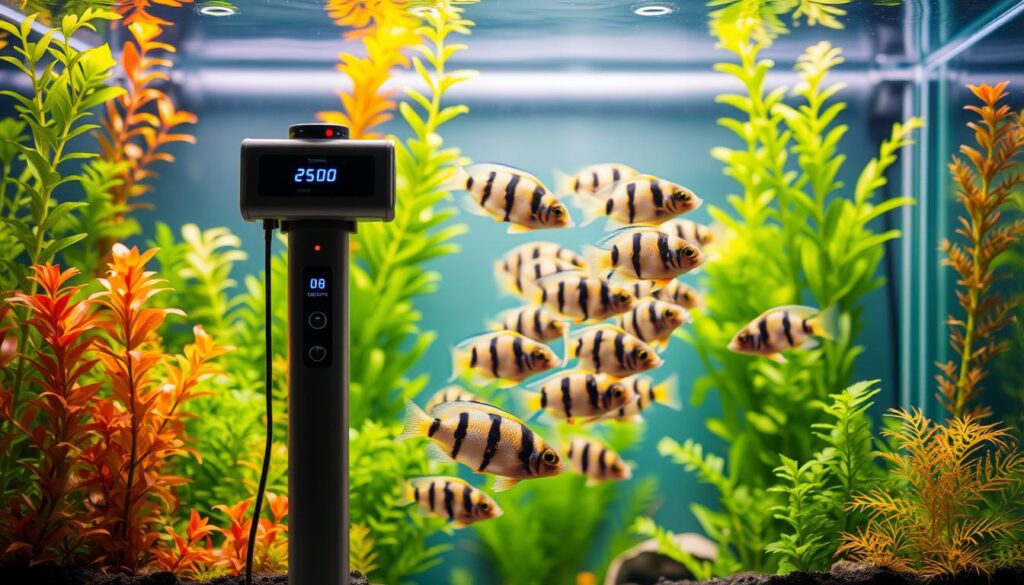
Thermometers and Temperature Monitoring
Use thermometers to track water conditions. Digital thermometers like the ATO Digital Thermometer are accurate. Analog sticks are more affordable.
Use two thermometers: one near the heater and one in open water. For advanced setups, remote monitors like the Seneye Reef connect to smartphones for alerts.
Backup Systems for Temperature Control
Power outages or heater failures need backups. Keep a spare heater plugged in nearby. Use heater guards to protect fish.
Invest in a battery-operated heater for emergencies. A fish tank temperature control plan keeps your tank stable even in unexpected issues.
“A well-placed heater and dual thermometers are the foundation of a stable aquarium.” – Aquarium Care Network
Signs Your Zebra Danios Are Experiencing Temperature Stress
Spotting zebra danio temperature stress early is key to avoiding danio fish health problems. Look out for these signs:
- Rapid gill movement: Overactive gills show stress from too hot water.
- Surface gasping: Fish having trouble breathing near the surface might lack oxygen due to extreme temperatures.
- Lethargy or hyperactivity: Being very slow or swimming too fast are signs of discomfort.
- Loss of appetite: Not wanting to eat often happens when the water temperature is off for too long.
- Color changes: If their stripes fade or they turn dark, it’s a sign of long-term stress.
- Clamped fins: Fins held tight to the body mean the fish is stressed.
- Aggression or hiding: Stress can make fish fight more or hide a lot.
Quick action is needed when stress from sudden temperature changes happens. Long-term exposure to the wrong temperatures weakens their immune system. This makes them more likely to get sick with things like ich or fin rot. If you see these signs, check the water every day. For more on stress, check out Chewy’s guide to aquarium stress. Acting fast helps keep your fish healthy for a long time.
Common Temperature-Related Mistakes to Avoid
Keeping zebra danios healthy means avoiding common mistakes. These errors often come from not paying attention, leading to problems with the tank’s temperature. Let’s look at the main mistakes and how to correct them.
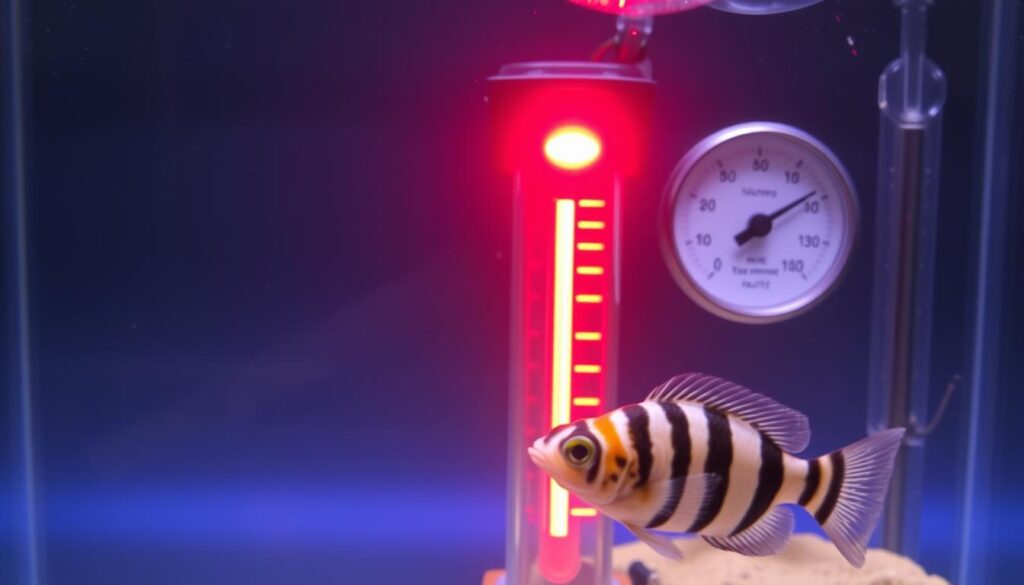
Sudden Temperature Changes
Big changes in water temperature can shock zebra danios. A change of 5°F or more can make them sick. These issues can come from:
- Adding water that’s too warm or cold during partial changes
- Heater malfunctions not caught early
- Placing tanks near windows or heating vents
To fix this, always match the water temperature to the tank’s before adding it. Check heaters weekly and keep tanks away from drafts.
Incorrect Heater Placement
Heaters placed wrong can cause uneven heating. Putting them too close to gravel or corners traps heat. This can lead to:
- Burn injuries near heater surfaces
- Cold spots in open areas of the tank
Place heaters vertically in the tank’s middle. Make sure they’re fully in the water. Use a thermostat to keep the heat even.
Inadequate Temperature Monitoring
Not checking the tank’s temperature regularly can cause problems. Many people only look at the heater display, which can be off. This can lead to:
| Mistake | Impact | Fix |
|---|---|---|
| No daily thermometer use | Unstable conditions | Check temps twice weekly |
| Single-point measurements | Inaccurate readings | Test water in multiple spots |
| Outdated thermometers | False readings | Calibrate tools monthly |
Controlling the temperature for zebra danios requires careful attention. By avoiding these mistakes, you can keep your fish healthy and happy.
How to Safely Adjust Zebra Danio Temperature
Changing the aquarium temperature needs careful planning to keep your fish safe. Follow these steps to help your fish adjust without stress.
Gradual Temperature Changes
When you need to change the aquarium temperature, focus on zebra danio acclimation. Here’s how:
- First, check the current temperature with a good thermometer.
- Slowly raise or lower the heater by 1–2°F each day.
- Watch your fish every day for any signs of stress.
- Don’t make big changes when they’re breeding or spawning.
For more tips, check out Aqueon’s zebra danio guide for detailed advice.
Emergency Temperature Adjustments
Here’s what to do in urgent situations:
| Issue | Solution |
|---|---|
| Overheating (above 80°F) | Float frozen water bottles in a sealed bag to cool gradually |
| Cold shock (below 68°F) | Wrap tank with insulation blankets and add warm water slowly |
Always keep water moving with aeration to prevent stress during temperature changes.
Be patient—sudden changes can be too much for them. Stay consistent to keep your zebra danios healthy and active.
Compatible Tank Mates That Share Similar Temperature Requirements
Zebra danios do best in community tank temperature zones between 64°F to 74°F. When picking zebra danio tank mates, look for ones with compatible fish temperature ranges. This keeps your tank peaceful and healthy. Here’s a quick guide to the best friends for your danios:
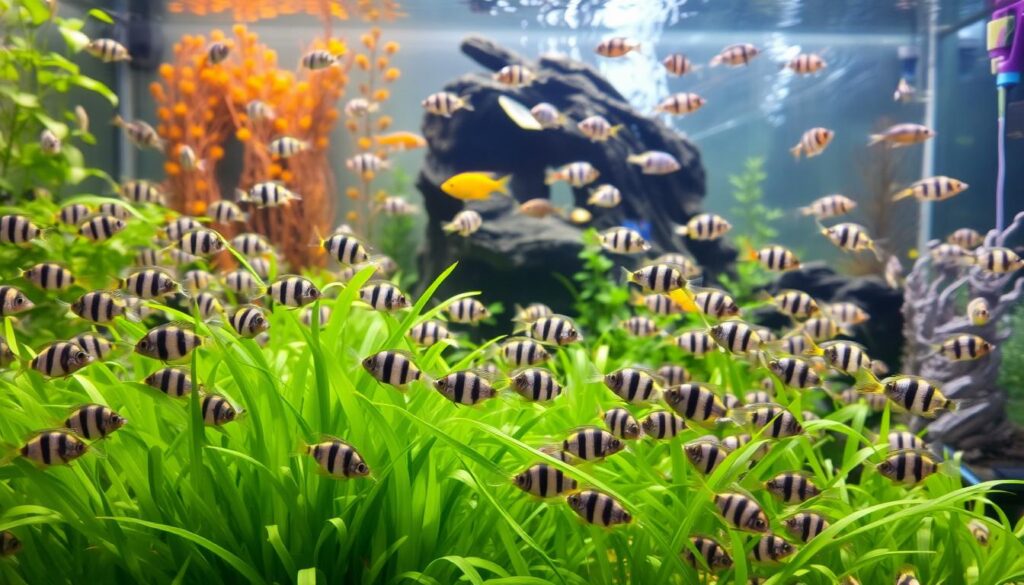
- Neon Tetras: 70–81°F. Their small size and schooling habits pair well with active danios.
- Corydoras Catfish: 72–78°F. Bottom dwellers that avoid temperature conflicts with midwater danios.
- White Cloud Mountain Minnows: 64–72°F. Hardy swimmers with matching cold-tolerant needs.
- Cherry Barbs: 68–78°F. Peaceful schooling fish that enjoy similar activity levels.
“A successful community tank starts with aligning temperature needs first,” says the American Aquarium Society.
Stay away from fish like discus (82–86°F) or goldfish (60–65°F). Make sure they have the same pH preferences—most like neutral to slightly acidic water. Also, check their space needs to avoid overcrowding. Always acclimate new fish slowly to match your tank’s community tank temperature settings.
Seasonal Considerations for Maintaining Aquarium Temperature
Seasonal changes require careful zebra danio temperature control. This keeps their home safe. Whether it’s summer heat or winter cold, a stable tank temperature is key. Here’s how to adjust your aquarium with the seasons.
Summer Heat Management
Extreme heat can raise water temperatures. Here are some tips:
- Move tanks away from windows to avoid sunlight exposure.
- Use fans near the tank surface to cool water without direct airflow on fish.
- Shorten lighting time to reduce heat buildup.
- Install an aquarium chiller for persistent high temperatures.
- Feed smaller portions—higher metabolism in warm water means less food waste.
Winter Temperature Stabilization
Cold weather can drop water temperatures. Here’s what to do:
- Wrap tanks with insulating foam or blankets to retain heat.
- Seal windows near aquariums to block drafts.
- Use a thermostat to monitor nighttime fluctuations.
- Have backup batteries or heaters ready during power outages.
Planning ahead with these strategies helps avoid stress from sudden seasonal aquarium temperature shifts. Regular checks with a thermometer ensure zebra danios stay in their ideal range all year.
Conclusion
Keeping the water at the right temperature is key for zebra danios to be happy and healthy. Stick to the temperature guidelines to ensure their well-being. Aim for a stable range of 72°F to 76°F (22°C–24.5°C). This range is more important than exact numbers.
Using good equipment like heaters and thermometers is crucial. Regular checks help avoid sudden changes that stress fish. Avoid big temperature changes and make sure heaters are placed right.
A good home for danios has steady temperatures, clean water, and the right tank mates. Healthy fish swim well and act naturally in a habitat that feels like their wild home. By keeping things balanced, you help your danios live longer and stay colorful.
Small changes, like adjusting heaters in summer or keeping tanks warm in winter, help keep things stable. Taking care of these details makes your aquarium a great place for your zebra danios. With consistent care and attention to temperature, you’ll enjoy watching them thrive for years.
FAQ
What is the ideal temperature range for zebra danios?
Zebra danios do best in temperatures between 72-76°F (22-24.5°C). This range helps them thrive and behave naturally.
Can zebra danios survive in lower temperatures?
Yes, they can survive down to 65°F (18°C). But, they might get tired and sick if it’s below 68°F (20°C).
How do temperature fluctuations affect zebra danio health?
Changes in temperature can stress them out. This weakens their immune system and makes them more likely to get sick. Keeping the temperature steady is key.
What signs indicate that my zebra danios are experiencing temperature stress?
Look for signs like fast gill movement, gasping, being very tired, not eating, or hiding a lot.
How can I safely adjust the temperature in my aquarium?
Slowly change the temperature by no more than 1-2°F each day. This helps them adjust without getting stressed.
Are there any specific equipment recommendations for maintaining proper temperature?
Use a submersible heater with a thermostat, accurate thermometers, and have backup heaters for control.
What are common mistakes to avoid when managing aquarium temperature?
Avoid sudden temperature changes, wrong heater placement, and not checking the temperature enough. Always check different parts of the tank for accurate readings.
What temperature-related behavior changes should I watch for in my zebra danios?
Watch how active they are. Higher safe temperatures can make them more energetic. Lower temperatures might make them slow and hide more.
Are zebra danios affected by seasonal temperature variations in their natural habitat?
Yes, they face seasonal temperature changes in the wild. But, it’s not usually needed to replicate these in home aquariums.
Can zebra danios be kept with other fish that have similar temperature requirements?
Yes, they can live with fish like tetras, corydoras, and platies. Just make sure their temperature needs match.

